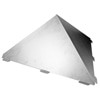Back to Blogs
All About Snow Splitter: Installation, Common Problems, and Maintenance Guide
January 4, 2024

Snow splitters play a crucial role in preventing snow buildup on your chimney, ensuring the safety and functionality of your heating system. This comprehensive guide covers everything you need to know about snow splitters, including step-by-step installation, common problems, and effective maintenance practices.
Step-by-Step Installation of Snow Splitter:
1. Gather Necessary Tools and Materials:
Before you begin the installation process, ensure you have the following tools and materials:
- Snow Splitter Kit
- Screwdriver or Drill
- Stainless Steel Screws
- Tape Measure
- Chalk or Pencil
2. Choose the Right Snow Splitter:
Select a snow splitter that matches the specifications and design preferences of your chimney system. Consider factors such as material, size, and effectiveness in preventing snow buildup.
3. Measure and Mark the Installation Point:
Measure the designated installation point on your chimney and mark it clearly using chalk or a pencil. Ensure accurate placement to effectively divert snow away from the chimney.
4. Align the Snow Splitter:
Align the snow splitter with the marked installation point on the chimney. Ensure it is positioned to effectively intercept falling snow and prevent accumulation on the chimney surface.
5. Secure the Snow Splitter to the Chimney:
Using a screwdriver or drill, securely attach the snow splitter to the marked installation point on the chimney. Utilize stainless steel screws for a durable and corrosion-resistant connection.
6. Inspect and Ensure Stability:
Inspect the installed snow splitter to ensure it is stable and securely attached. Verify that it provides effective snow diversion without compromising the structural integrity of the chimney.
Common Problems with Snow Splitters:
Despite their effectiveness, snow splitters may encounter common problems. Be aware of these issues and address them promptly:
1. Ice Accumulation:
In freezing conditions, snow splitters may accumulate ice, reducing their effectiveness. Periodically remove ice buildup to maintain optimal functionality.
2. Damage from Ice or Debris:
Falling ice or debris can cause damage to the snow splitter. Regularly inspect for any signs of damage and promptly repair or replace affected parts.
3. Rust or Corrosion:
Exposure to the elements may lead to rust or corrosion. Choose high-quality, rust-resistant materials and regularly inspect for any signs of corrosion.
How to Take Care of Your Snow Splitter:
1. Clear Ice Accumulation:
In freezing conditions, clear any ice accumulation on the snow splitter to maintain its effectiveness in diverting snow away from the chimney.
2. Regular Inspection:
Perform regular inspections to check for damage, rust, or any signs of wear. Address issues promptly to ensure the continued functionality of the snow splitter.
3. Clean Debris:
Remove any debris, such as leaves or branches, that may accumulate on the snow splitter. This helps prevent clogs and maintains optimal performance.
Conclusion:
Installing a snow splitter is a proactive step in preventing snow buildup on your chimney. By following the step-by-step installation guide and addressing common problems through effective maintenance, you can ensure the longevity and effectiveness of your snow splitter, providing reliable protection for your chimney system.
